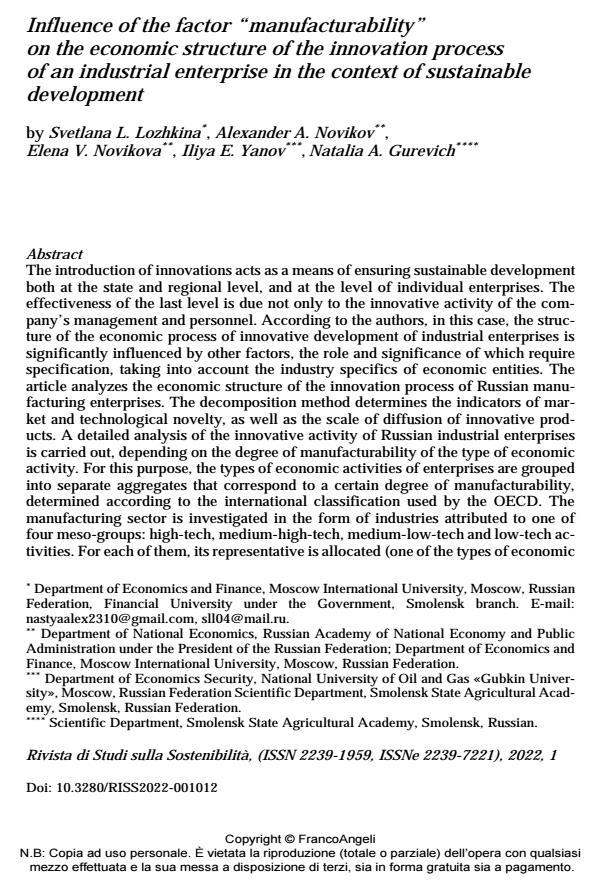Influence of the factor "manufacturability" on the economic structure of the innovation process of an industrial enterprise in the context of sustainable development
Titolo Rivista RIVISTA DI STUDI SULLA SOSTENIBILITA'
Autori/Curatori Svetlana L. Lozhkina, Alexander A. Novikov, Elena V. Novikova, Iliya E. Yanov, Natalia A. Gurevich
Anno di pubblicazione 2022 Fascicolo 2022/1
Lingua Inglese Numero pagine 14 P. 193-206 Dimensione file 221 KB
DOI 10.3280/RISS2022-001012
Il DOI è il codice a barre della proprietà intellettuale: per saperne di più
clicca qui
Qui sotto puoi vedere in anteprima la prima pagina di questo articolo.
Se questo articolo ti interessa, lo puoi acquistare (e scaricare in formato pdf) seguendo le facili indicazioni per acquistare il download credit. Acquista Download Credits per scaricare questo Articolo in formato PDF

FrancoAngeli è membro della Publishers International Linking Association, Inc (PILA)associazione indipendente e non profit per facilitare (attraverso i servizi tecnologici implementati da CrossRef.org) l’accesso degli studiosi ai contenuti digitali nelle pubblicazioni professionali e scientifiche
The introduction of innovations acts as a means of ensuring sustainable develop-ment both at the state and regional level, and at the level of individual enterprises. The effectiveness of the last level is due not only to the innovative activity of the company’s management and personnel. According to the authors, in this case, the structure of the economic process of innovative development of industrial enter-prises is significantly influenced by other factors, the role and significance of which require specification, taking into account the industry specifics of economic enti-ties. The article analyzes the economic structure of the innovation process of Rus-sian manufacturing enterprises. The decomposition method determines the indica-tors of market and technological novelty, as well as the scale of diffusion of inno-vative products. A detailed analysis of the innovative activity of Russian industrial enterprises is carried out, depending on the degree of manufacturability of the type of economic activity. For this purpose, the types of economic activities of enter-prises are grouped into separate aggregates that correspond to a certain degree of manufacturability, determined according to the international classification used by the OECD. The manufacturing sector is investigated in the form of industries attributed to one of four meso-groups: high-tech, medium-high-tech, medium-low-tech and low-tech activities. For each of them, its representative is allocated (one of the types of economic activity), the dynamic characteristics of innovation ac-tivity of which differ significantly from the characteristics of the group as a whole. The proposed approach allows us to study the dynamics of development and de-termine the main stages of the innovation process in the types of activities of manufacturing industries of various degrees of manufacturability. It was found that the highest innovative activity is characteristic of high-tech Russian enterpris-es. A decrease in the degree of manufacturability of production has a negative im-pact on the innovative activity of meso-groups in general. The exception is the class of low-tech industries. The innovative activity of the group of enterprises of low-tech industries is much higher than the activity of medium-high-tech indus-tries.
Parole chiave:degree of manufacturability, innovation process, market and techno-logical novelty, sustainable development
Svetlana L. Lozhkina, Alexander A. Novikov, Elena V. Novikova, Iliya E. Yanov, Natalia A. Gurevich, Influence of the factor "manufacturability" on the economic structure of the innovation process of an industrial enterprise in the context of sustainable development in "RIVISTA DI STUDI SULLA SOSTENIBILITA'" 1/2022, pp 193-206, DOI: 10.3280/RISS2022-001012